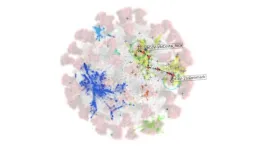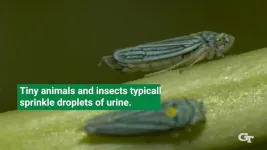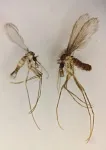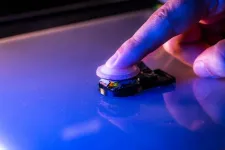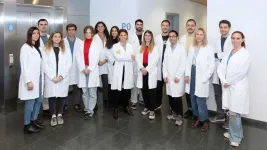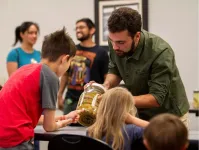(Press-News.org) Some cancerous tumors hijack proteins that act as “brakes” on our immune system and use them to form a sort of shield against immune recognition. Immunotherapy treatments have been created that turn off these “brakes” and allow our body to attack foreign-looking cancer cells. To further advance such treatments, researchers at Stanford University and New York University have published a new structure of one of these brake proteins, LAG-3. Their work contains key details of the molecule’s structure, as well as information about how the LAG-3 protein functions.
Although over a dozen immunotherapies targeting LAG-3 are in development, and one is already FDA approved, knowledge of LAG-3’s structure and function has been incomplete.
“Given the amount of time and resources being put into developing therapeutics that target LAG-3, it is astounding that we don’t yet have a full understanding of how this protein functions,” said Jennifer Cochran, the Addie and Al Macovski Professor in the School of Engineering and professor of bioengineering, and co-senior author on the study detailing LAG-3, published in Proceedings of the National Academy of Sciences.
Getting a clear image of a protein might not seem like a big deal, but when it comes to proteins, form often begets function. If you know what a protein looks like at the atomic scale, you can begin to understand how it interacts with other molecules and design experiments to further deduce how it works. Studies like these are crucial to developing drugs that can optimally block their target’s function.
A key structure
Proteins like LAG-3, called immune checkpoints, exist to stop our immune system from attacking things they shouldn’t. In theory, our immune system should naturally recognize tumor cells as foreign. But a checkpoint protein shield can give cancer cover.
Current immunotherapies aren’t chemical drugs, they’re lab-manufactured antibodies that attach to certain parts of these checkpoints, and essentially turn them off. Once the checkpoint is turned off, our immune system can recognize and target the cancer again.
There are already approved antibody treatments that target two checkpoint proteins: CTLA-4 and PD-1. Both turn off our immune systems but in different ways. Because CTLA-4 and PD-1 were the first two checkpoint proteins found, they are quite well studied, and different approaches to inhibiting them for cancer therapy earned scientists the 2018 Nobel Prize in physiology or medicine.
LAG-3 seems to work in an entirely different way. Scientists hope that those differences might make it a better or complementary target to treat certain types of cancer, said Jack Silberstein, the Stanford immunology PhD student who co-led the work.
Because of that, Silberstein said, “there was all this excitement in the field. Groups rushed to make antibodies against LAG-3, without knowing entirely how LAG-3 or those antibodies functioned.”
Silberstein and colleagues, including those in Stanford’s ChEM-H Macromolecular Structure Knowledge Center and the SLAC National Accelerator Laboratory, began working on LAG-3’s structure in 2019. A structure of LAG-3 was published by a different group in 2022 providing an initial glimpse of the protein, but it lacked crucial detail around sugar molecules that are key to LAG-3’s function, and detailed information on how the LAG-3 structure related to its biological activity.
A painstaking process
When Silberstein first started this project, “I quickly realized why there was no published structure. It’s a tremendously difficult protein to work with.”
And the technique Silberstein used to get the structure, called X-ray crystallography, is extremely finicky. First, Silberstein had to grow a crystal made entirely out of LAG-3 protein. Then, in collaboration with Irimpan Mathews at the SLAC National Accelerator Laboratory, they fired X-ray beams at the crystal to create a 3D image of the molecule.
LAG-3 is a spindly, flexible protein, so it’s difficult to get the molecules to stack in an orderly way. Silberstein estimates he made more than 10,000 crystals, of which 3,000 were fired with X-rays before the team finally solved the structure.
“It was a very intense, grind-it-out-for-three-years, bang-your-head-against-the-wall kind of thing,” Silberstein said.
But it paid off. The team’s structure confirmed that LAG-3 exists as a dimer, with two LAG-3 molecules coming together to form the functional checkpoint protein. The sugar residue that was elusive in previous structural efforts is a key element in the LAG-3 dimer interface and helps promote a different orientation of the LAG-3 protein.
With the structure described, colleagues at New York University, including MD, PhD student Jasper Du and pathology Assistant Professor Jun Wang co-led critical experiments further elucidating LAG-3’s function. Other NYU colleagues, including Kun-Wei Chan and Xiang-Peng Kong, helped conduct electron microscopy studies to detail disruption of dimer formation by LAG-3 antibodies.
Additional work by the team uncovered, for the first time, that an antibody that has been used for close to 20 years to demonstrate therapeutic efficacy in animal tumor models blocks the activity of LAG-3 by binding to the interface between two LAG-3 molecules, disrupting LAG-3 from forming its functional dimer. Intriguingly, LAG-3 antibodies in clinical development bind to other areas of the protein, away from this dimer interface.
There will never be just one “cure,” because cancers are all different and involve a number of diverse biochemical pathways. Silberstein and Cochran envision a future where a tapestry of surgical, chemical, and immunological treatment approaches are employed, driven by basic science discoveries and medical innovations. Additional treatments targeting LAG-3 may very well be a part of that picture.
Additional Stanford co-authors are Jessica Frank, BS ’22 in bioengineering, MS ’23 in computer science; Irimpan Mathews, lead scientist at SLAC National Accelerator Laboratory; graduate students Yong Bin Kim, Phillip Liu, and Grayson Rodriguez; and Daniel Fernandez, director of crystallography at Sarafan ChEM-H. Additional co-authors are from New York University.
Cochran is also the senior associate vice provost for research and professor by courtesy, of chemical engineering. She is a member of Stanford Bio-X, the Cardiovascular Institute, the Maternal & Child Health Research Institute (MCHRI), the Stanford Cancer Institute, and the Wu Tsai Neurosciences Institute, and a faculty fellow of Sarafan ChEM-H.
This work was funded by Stanford Bio-X, the National Institutes of Health, the National Institute of Arthritis and Musculoskeletal and Skin Diseases, an Enhancing Diversity in Graduate Education (EDGE) Fellowship, National Science Foundation graduate fellowships, a Cancer Research Institute Irvington Postdoctoral Fellowship, the Stanford Molecular Biophysics Training Program, a Stanford Graduate Fellowship in Science & Engineering, the NIH Melanoma Research Alliance, the V Foundation, the Mark Foundation, the NYU Colton Center for Autoimmunity, and the Emerson Collective Cancer Research Fund.
END
This protein pic could help develop new cancer treatments
2024-03-11
ELSE PRESS RELEASES FROM THIS DATE:
Mathematicians use AI to identify emerging COVID-19 variants
2024-03-11
Scientists at The Universities of Manchester and Oxford have developed an AI framework that can identify and track new and concerning COVID-19 variants and could help with other infections in the future.
The framework combines dimension reduction techniques and a new explainable clustering algorithm called CLASSIX, developed by mathematicians at The University of Manchester. This enables the quick identification of groups of viral genomes that might present a risk in the future from huge volumes of data.
The study, presented this week ...
Cicadas’ unique urination unlocks new understanding of fluid dynamics
2024-03-11
Cicadas are the soundtrack of summer, but their pee is more special than their music. Rather than sprinkling droplets, they emit jets of urine from their small frames. For years, Georgia Tech researchers have wanted to understand the cicada’s unique urination.
Saad Bhamla, an assistant professor in the School of Chemical and Biochemical Engineering, and his research group hoped for an opportunity to study a cicada’s fluid excretion. However, while cicadas are easily heard, they hide in trees, making them hard to observe. As such, seeing a cicada pee is an event. Bhamla’s team had only watched the process on YouTube.
Then, ...
New research sets trap for potentially deadly sandfly
2024-03-11
Scientists have discovered the specific enzyme that a species of sandfly uses to produce a pheromone attractant, which could lead to the creation of targeted traps to control them and reduce the spread of the potentially fatal disease, Leishmaniasis.
The team from the University of Nottingham’s School of Chemistry analysed the genome of the Lutzomyia longipalpis, a species of sandfly native to Brazil and South America that can spread a disease called Leishmaniasis.
The study identified the enzyme, called a Terpene Synthase that is responsible ...
A new sensor detects harmful “forever chemicals” in drinking water
2024-03-11
CAMBRIDGE, MA -- MIT chemists have designed a sensor that detects tiny quantities of perfluoroalkyl and polyfluoroalkyl substances (PFAS) — chemicals found in food packaging, nonstick cookware, and many other consumer products.
These compounds, also known as “forever chemicals” because they do not break down naturally, have been linked to a variety of harmful health effects, including cancer, reproductive problems, and disruption of the immune and endocrine systems.
Using the new sensor technology, the researchers showed that they could detect PFAS levels as low as 200 parts per trillion in a water sample. The device they designed could offer a way ...
Robotic interface masters a soft touch
2024-03-11
The perception of softness can be taken for granted, but it plays a crucial role in many actions and interactions – from judging the ripeness of an avocado to conducting a medical exam, or holding the hand of a loved one. But understanding and reproducing softness perception is challenging, because it involves so many sensory and cognitive processes.
Robotics researchers have tried to address this challenge with haptic devices, but previous attempts have not distinguished between two primary elements of softness perception: cutaneous cues (sensory feedback ...
Tuberculosis bacteria also present in 90% of those with symptoms, who are not diagnosed with TB
2024-03-11
Mycobacterium tuberculosis (Mtb), the bacteria that causes a tuberculosis infection, is present in exhaled breath of 90% of those presenting with suspected tuberculosis. This includes those who were negative on conventional sputum testing and not diagnosed with TB. This raises the possibility that those who have tested negative may be unknowingly transmitting the infection. Researchers from the University of Cape Town and Amsterdam UMC analysed results from over 100 patients who presented themselves to clinics in South Africa. These findings are published today in PNAS.
“If ...
U of M-led study reveals shared blueprint in brain development across different functional areas
2024-03-11
In a new study published in Proceedings of the National Academy of Sciences (PNAS), researchers from the University of Minnesota Medical School investigated brain development to understand how different areas of the brain become specialized in handling information such as vision, sound, touch and planning.
The study found that different areas of the brain start with a similar organization rather than already being specialized in early development. This suggests that the brain might use a single shared blueprint to guide early development.
“Throughout life, the brain continually builds on the foundations set ...
Researchers solve crucial cold-induced sweetening problem in potato production
2024-03-11
Researchers have discovered a game changer for the potato industry.
According to a new study published in a leading international society journal published by the American Society of Plant Biologists, a small genetic element is the cause of a major production problem in potatoes.
“Our manuscript reveals the mystery of “cold-induced sweetening” (CIS), the most troublesome and expensive problem for the potato processing industry,” explained Jiming Jiang, Corresponding Author of “Molecular dissection of an intronic enhancer governing cold-induced expression ...
Developed by VHIO, a novel AI-based and non-invasive diagnostic tool enables accurate brain tumor diagnosis, outperforming current classification methods
2024-03-11
Developed by VHIO, a novel AI-based and non-invasive diagnostic tool enables accurate brain tumor diagnosis, outperforming current classification methods
Developed by VHIO’s Radiomics Group in close collaboration with researchers of the Neuroradiology Unit at the Bellvitge University Hospital (HUB), DISCERN is a deep learning tool that leverages information of magnetic resonance imaging and facilitates brain tumor classification to aid clinical decision making.
Currently, a definitive diagnosis often requires neurosurgical interventions that compromise the quality of life of patients.
Trained to differentiate between the three most ...
Natural history specimens have never been so accessible
2024-03-11
With the help of 16 grants from the National Science Foundation, researchers have painstakingly taken computed topography (CT) scans of more than 13,000 individual specimens to create 3D images of more than half of all the world's animal groups, including mammals, fishes, amphibians and reptiles.
The research team, made of members from The University of Texas at Arlington and 25 other institutions, are now a quarter of the way through inputting nearly 30,000 media files to the open-source repository MorphoSource. This will allow researchers ...
